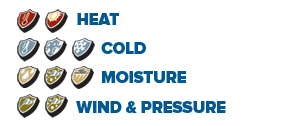VAPOR BARRIERS AND THEIR FUNCTION WITHIN THE BUILDING ENVELOPE.
When insulating buildings became common practice in the 60's, moisture issues also came into being -mold growth due to condensation and the corresponding health problems and lawsuit issues became the new reality. After all was said and done over the years, we now understand how vapor transfer occurs in the building envelope.
There are those within the building sciences practice that argue if vapor barriers sandwiched within insulation on both cold and warm sides of the envelope will eliminate vapor drive in cold climates altogether. At the end of the day, this really doesn't make much sense for us. The truth is, we don't live in a cold climate. We live in a variable climate where one portion of the year is certainly cold, but the other half of the year reaches 30 degrees and 100% humidity, becoming a tropical climate. Since vapor pressure travels from hot to cold, the vapor drive occurs from the outside of a building to the inside during this time of year. Vapor pressure is an actual physical pressure pushing to get in to reach equilibrium. It will work its way through porous brick, cracks and any opening within the building before it reaches the vapor barrier. If there is no insulation but only a vapor barrier on the cold side of the envelope, vapor will become liquid depending on the percentage of humidity, temperature and air pressure. This 'dew point' will change as elevations increase, but moisturizing inside the building envelope will certainly happen. When wetting occurs, mold occurs.
During the winter, the vapor drive advances from the inside of the building to the outside. When vapor reaches the vapor barrier, it doesn't reach dew point due to insulation within. The building actually has a drying force working for it.
The best approach is to design the building envelope so the drying force on each side of the envelope is higher than the wetting force. The Oak Ridge National Laboratory tested these theories in the early 90's and influenced a change to the US building code. By implementing a self-drying roofing system that would be strong enough in the event of a leak within one season cycle, the building will now have enough self-drying potential to actually dry water accumulation from a roof leak entirely on its own.
When all is said and done, it makes more sense to apply a vapor barrier in the middle of insulation. This approach, regardless of which season it is, helps the building envelope accumulate no moisture at all.



